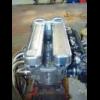Here's a sheet that I gave to customers (in the day);-
Engine Initial Start & Running In
Oil for Running In Period
Use Penrite Running In Oil. Do not subsitute.
Initial Engine Start
1) Prime the Oil Pump (from the Banjo Bolt on the front of the engine).
2) Be sure you have a GOOD Battery
3) Test the Oil Switch on the engine. Disconnect the Black Wire between the distributor and Coil. Turn the key to RUN, the Oil Light should come ON. Disconnect the wire from the Oil Switch, it should go OFF.
DO NOT PROCEED UNTIL THIS WORKS 100% RELIABLY
3) Fill with Fuel, Water and Oil etc. Do NOT fill with Coolant at this time, only clean tap water.
4) Ensure Brakes etc are working
5) Ensure the engine is dust free.Remove the spark plugs
6) Crank the engine over (it will sound 'funny') until the Oil Light goes OFF. This may take anything from 30 secs to 15 minutes.
7) Leave it sit for a Minute and check that the Oil Light comes back ON. Crank over again and check the Oil Light goes OFF, should only take ~ 5 - 10 seconds.
8) Check for Oil Leaks. Resolve.
9) Fit Spark Plugs and HT Leads, re-connect the wire from the Distributor to the coil.
10) Be sure you have your Licence with you!
11) Start and Drive it.
12) Drive with gental accelleration until up to temperature.
for the first 20 minutes, keep the RPMs above 2000 RPM, then set it to 1100 RPM (run in period for Cam and / or followers).
DO NOT EXCEED THE FOLLOWING SPEEDS;-
1ST 20 KPH
2ND 40 KPH
3RD 60 KPH
4TH 80 KPH
(Basically limiting to 3000 RPM Max - which incidentally is what the factory also recommend - see attached)
13) When up to temp (about 1 - 2 minutes), on a quiet road, drive up to 50 KPH, Then in 4th Gear, accellerate HARD from 50 KPH to 80 KPH.
Do this 3 times NO MORE. Don't let the engine 'Ping'.
14) Return to Base and check over. Resolve any issues and Leave overnight.
15) Re-tension the Cylinder Head (50 ft/lbs or as recommended by the stud supplier) and Re-set the Tappets (0.012")
16) Drive around locally, observing your limited speeds, for around 200 km.
17) If all is OK, continue driving for 1000 km in total.
18) Change Oil and Filter. Re-tension Cylinder Head and Re-set Tappets.
19) It's now run in.
20) Set idle to 650 RPM, check Ignition Timing and Carb Mixture.
21) Check for leaks, noises etc.
GOLDEN RULES while running in;-
DO NOT accellerate hard - ever
DO NOT Over-rev it (observe above limited speeds) - ever
Don't let it over-heat
Avoid Idling, up to 30 seconds is OK, but don't let it go on any longer. After you've done about 600 km, it will be OK to idle for longer periods, but still try to avoid it.
Avoid sitting on the one speed. It will be OK for a minute or so, but keep the revs changing.
Drive 'normally'
Don't ever let the engine 'Ping'
After Running In Period
Re-check Cylinder Head Tension
Re-set Tappets
Change Oil and Filter. Recommended Oil Penrite HPR30.
Drain Cooling System (ensure heater is set to HOT), flush with clean water, drain and then fill with Coolant. Castrol have a good one. Do not use Tecalloy.





















